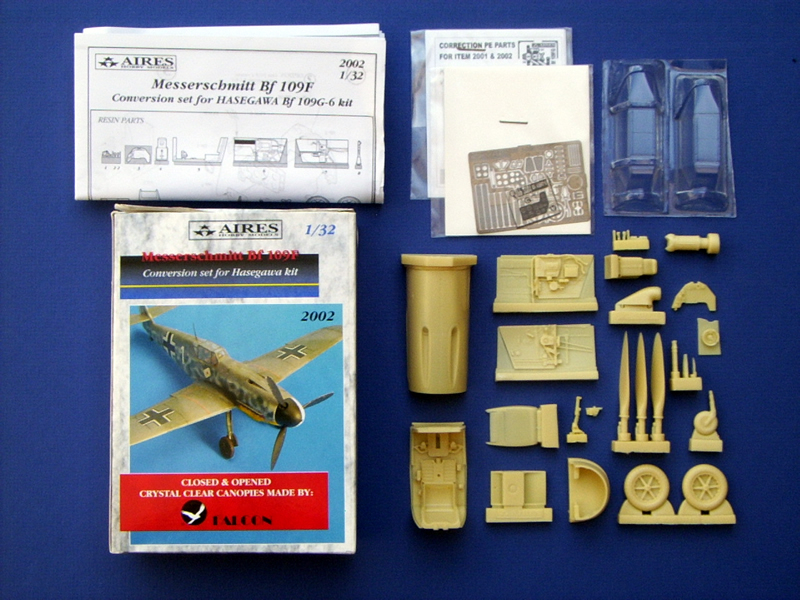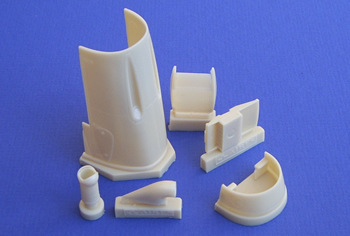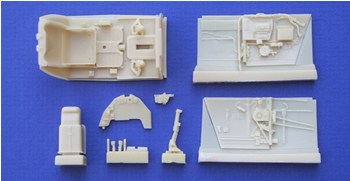Aires | 1/32 Bf 109F Conversion Set
Reviewed by Steve Messer

The nagging question for many large scale '109 nuts has been "Where's the F?" Hasegawa has already produced most of the moulds necessary for an F model, and one of the sprues in their G4 kit is even marked "Bf109F"! So, why there's been no F to date, and when or if we'll see one, remains a mystery. For those who can't wait, there's always Aires' Bf 109F conversion Set.
Inside the box, you'll find 27 resin parts, two photo-etched frets, two vacuformed canopies by Falcon (one each closed and opened versions), and the instruction sheet. Designed to fit the Hasegawa 1/32nd scale G-6 kit, parts are provided for a new nose section, replacement cockpit and other items required for an accurate 109F. The modeller is free to use all of the parts, or mix and match with the equivalent Hasegawa parts to create different versions, eg: an F4/Z. Some kit-bashing experience will be necessary, as portions of the donor kit's fuselage will need to be removed.

The new cowling is thin in cross section and well detailed, and it's evident from some of the panel lines and the gun trough shapes that this is an original casting, and not simply a copy of Hasegawa's G4. There's a small amount of flash across the gun openings, which pops out nicely, eliminating the need to drill them out. The moulded stops inside the cowling are offset, and when the Aires-supplied MG's are inserted against them, gives the correct assymetrical positioning for the guns. Also included are a new smaller underside oil cooler cover and radiator matrix, and a new front oil tank cover, this part and the cowling both correctly lacking the later G series cooling scoops. That all said however, the length of the new cowling seems about a millimetre too short... not a big deal, but more later.

A new drop-in cockpit is provided, detail is quite good and the construction is somewhat simplified by the integral moulding of the seat, tread plate, and footrest pistons to the cockpit floor. This generic floor is the same as found in Aires' G-6 cokpit set, and has an opening in the firewall and provision for adding an engine mounted cannon (not included), for display without the the provided gun cover in place. Resin sidewalls, stick and gunsight are there, the instrument panel being combination of an acetate dial sheet sandwiched between a resin panel backing and photo-etched bezels on top. Other p/e details on the frets supplied are seatbelt hardware, trim tabs, longitudinal stiffeners for the tail section, and two sets of pedals... an amended set is provided, as the originals were perhaps considered a little undersized.
Rounding out the set are: resin main wheels, tail wheel, new propeller blades and supercharger intake with separate tropical filter an hardware, the vac canopies, and instruction sheet. The prop blades are good representations, as is the tropical filter with it's baffle moulded open. But whereas the main wheels are the correct scale diameter and width, the hub's cross-spokes look a little thin for my liking. The tail wheel abounds with great detail, from the hub to the tyre's fine tread lines, but in an era where most aftermarket suppliers are making separate tail wheels and yokes, the Aires parts are moulded integrally! A smaller supercharger intake is provided, but it's mounting plate is moulded to the cowling side, making it a pain to fill the subsequent join when it could have easily been made as one piece for attaching flush to the cowling. The Falcon vac canopies are clear enough, but not quite "crystal" as the box-top suggests... the purists may wish to add some internal bracing as the framing is noticeably thin. Rounding out the contents is the instruction sheet, for the most part clear and concise, but lacking any colour guide whatsoever.


This is where the "but more later" comes in. The instructions on how and where to remove the Hasegawa fuselage are vague at best. Going by the illustration on the sheet, all of the cowling should be removed, but it looks to be a tighter fit if rear lip is retained. This lip will then need to be filled over, as it was a feature the later G series, and not present on the F... no mention is made of this. The instructions also fail to highlight most of the G series panels that need filling on the fuselage, only one being singled out. More than ever, the modeller needs to thoroughly check all references.
In conclusion, this is a very good conversion set, but it's perhaps not quite the best it could be. Everything required for an accurate Bf 109F is included, and the detail of the parts provided is very good, but the approaches taken towards the supercharger and tailwheel mouldings bring it down a notch, as do the shortcomings of the instruction sheet to some degree. Those with less experience may wish to omit the resin cowl altogether and use the Hasegawa G4 kit as the basis of a 109F project, the scoops on that kit's cowling can be removed and filled to create a reasonable F profile, without the need to cut up the fuselage. Alternately, others may wish to halve the resin cowl, add internal ribbing and an engine, and go to town! Either way, this set is thoroughly recommended, as the best 1/32nd scale Bf 109F option to date.
© Steve Messer 2006
This review was published on Saturday, July 02 2011; Last modified on Wednesday, May 18 2016
